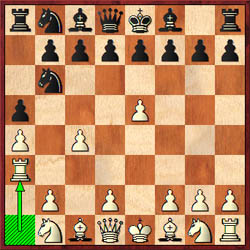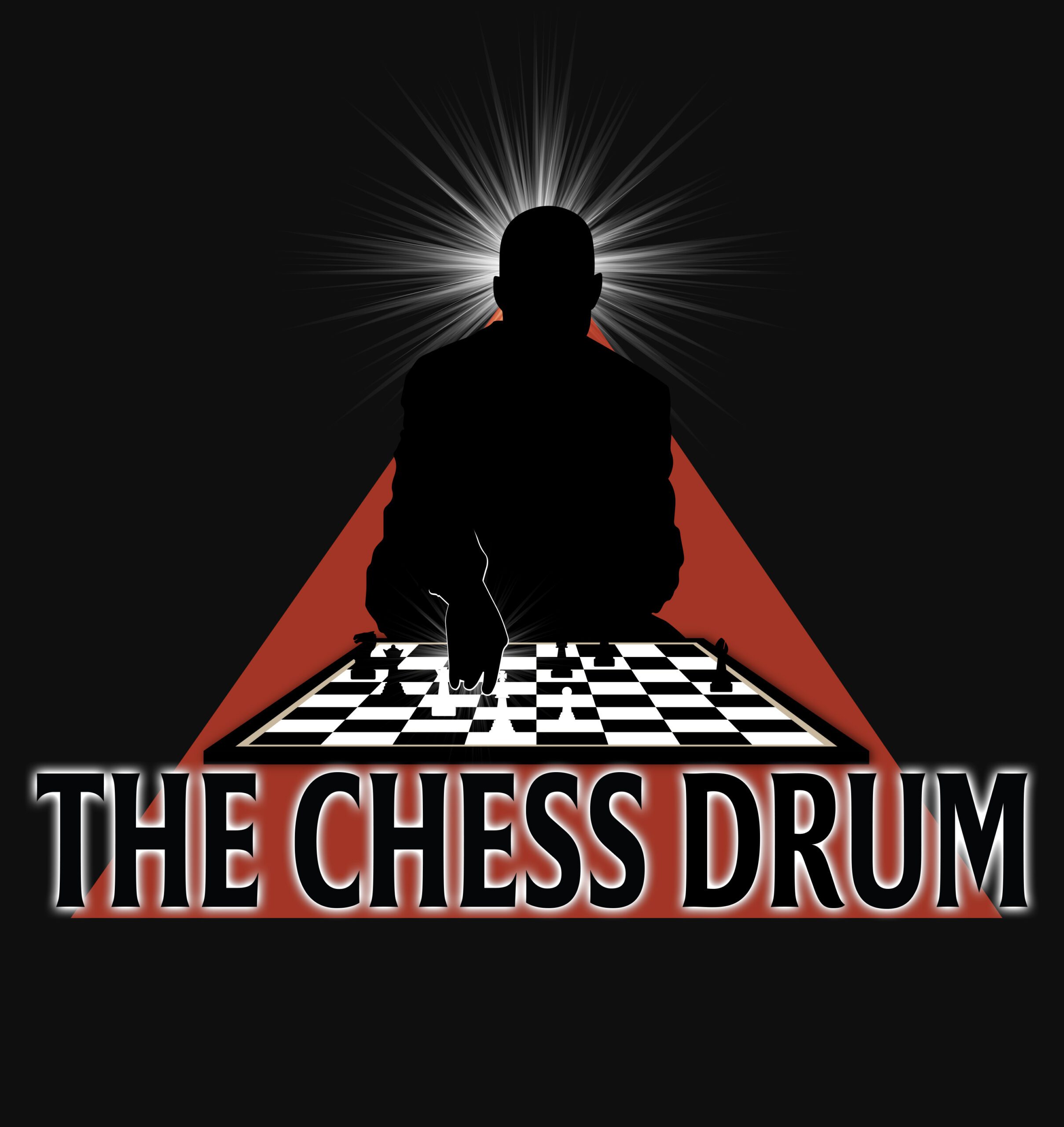The Emory Tate Variation
There may not be many players who can say they have a variation named after them, but International Master Emory Tate is one of them. With a fan base of cultist proportions, Tate has dazzled the chess arena for more than three decades with his tactical wizardry. What most may underestimate about Tate is the richness and originality of his ideas. His ideas are not only tactical, but often entail deep positional themes. Of course, the “Emory Tate Variation” is one of the ideas that shows diabolical intent from the outset.

Back in the late 80s, Tate began experimenting with a particular treatment against the Alekhine. Of course there are many systems against the unorthodox defense. However, in a game at the 1988 Armed Forces Championship, the game between Tate and Paul Waldowski started 1. e4 Nf6 2. e5 Nd5 3. c4 Nb6 4. a4!? a5 5. Ra3!!? (diagram) This game was quickly drawn, but the variation began to take on a life of its own.
While the idea may be hidden in some obscure notes, there does not seem to be a record of this idea being tested in a serious competition until 1988. In a return encounter against Waldowski the next year, he varied with 1. e4 Nf6 2. e5 Nd5 3.a4!? c5 4.Ra3!? Nc6 5.Rg3. Tate lost that encounter, but he showed a willingness to test this new idea. A couple of years later, he played another game at the Giessen Open against Manfred Herfel, winning in slashing style.
This line was once the subject of a long thread on a discussion board named “The Emory Tate Variation”. That board has since disappeared, but the topic pops up every now and them. IM Igor Khmelnitsky mentioned it in analysis on the Alekhine though he does not give Tate credit for its inception. He calls it the “Chase Variation”. While he fails to use the earliest games of the Tate variation, he uses illustrative examples of Tate-Herfel (1991 Giessen Open, 1-0, 30), Doss-Weinberg (1999 Texas Ch., 0-1, 37) and Muzychuk-Petrenko (2003 EU Women’s Ch., 1-0, 54). Ukrainian-born Anna Muzychuk was about 11 years old when she was surprising opponents with this opening. She is now a strong Master and represents Slovenia.
While there are many skeptics, the opening has some interesting motifs. The rook is brought into play almost immediately since black neglected to create space. The rook is usually the last piece developed in chess, not the first. Rooks are also brought to the center serving as support for pawn breaks. This is a classical example where white breaks several “rules”. If we look at the moves 4.a4!? and 5.Ra3!!? they look like beginner moves, but they appear logical in that the rook has a clear path on the third rank from which to travel freely. The rook is also very difficult to attack and can cripple black’s kingside long enough to pry the center open. Of course, there are some drawbacks to this original idea.
While it is not the point of this essay to deeply analyze the variation, it shows a creative spirit in chess that is often lacking in an age increasingly reliant on computers. In recent times, Emory Tate has continued to enthrall crowds of onlookers at analysis sessions with his amazingly creative ideas. Many have argued that he would have become a Grandmaster if he toned down his reliance on tactics. That point has been debated for decades. Nevertheless, the chess world has certainly benefited from Tate’s creative and artistic contributions. The Tate variation shows his legacy of creativity and inventiveness… and courage to test ideas.
(Selected Games, 5.Ra3 PGN download)


The consensus is that black has few worries if they play accurately. The 5…d6 line seems to be the most common. However, white looks to have some play. I’d certainly play it.
An interesting idea, although it seems White has problems transferring this Rook to a useful square. After Black plays Bf5, either White blocks the third rank with Nc3 (killing this a3 Rook) or Nd2, passive position for this Knight. Maybe just the natural Bd3 against Bf5, follow by capture on d3 with his Rook, ops, c4 hangs. Ok, capture with his Queen.
He can transfer it immediately to g3 and protect the knight by moving the c1-bishop. I believe timing is the key in this idea. Some of the games, white tries d4 first and the rook gets hemmed in with Nc3 or Be3. In some of the games, white played an early Rg3. I like Piven’s maneuver of 7…Be7 and 8…Bf6 after white delayed Rg3. I believe it’s interesting that you can get a rook into play that fast because it presents options not available on e1 and d1. You can really change the flow of play by swinging rooks from one side to the other. However, I believe the idea has to undergo more rigorous tests.
By looking at the games, it appears that the idea spread when Tate played in Germany and then to the Ukraine where several juniors were taught the idea and then to Spain. Of course Tate played it on the east coast of the U.S. as well.
gracias!! estaré estudiando las ideas de Tate!! hi is a nice chess player! ,’=+) from Venezuela G3rm@n
I like Nepomniachtchi’s game against Kramnik where he uses early rook lifts with great effect. Of course there are drawbacks.
Daaim,
I had the chance to speak with Nepomniatchi a couple of times in Siberia. His play, demeanour at the board etc. show that he is the real McKoy. After Kramnik, he and Grischuk will be the ones carrying the Russian flag in the next few years.
I believe Russia should have “cleaned house” and started the young guns on Russia “A”. Nepo and Jakovenko should have been on “A”.
With respect, I am not too sure about “cleaning house.” I still liked the Russian “A” team. Perhaps Nepom should have played instead of Malakhov, especially as he was/is the European champion. Looking at the Russian “B” team’s results I don’t think that they would have won had there been “house cleaning.” The “youngsters”, regardless of 2700 rating, still need more time.
Had the Russian “A” team not had a couple of adverse results (Grischuk losing when Kramnik was rested and Svidler losing to a much lower rated Spanish opponent) the Russians (with a number of “vets”) might well have won the whole thing.
In the final analysis I thought that justice was done and the Ukrainians deserved to win based particularly on their team spirit and Chucky’s outstanding play.
Ukrainians definitely deserved it! I wouldn’t say totally clean house, but I feel that Kramnik, Grischuk, Karjakin, Jakovenko and Nepomniachtchi would have been a good lineup… young and hungry with veteran leadership. Grischuk and Karjakin are steady veterans. This is the same formula that led Russia to the gold when Kasparov lead them in 2002. There was Kasparov, Grischuk, Khalifman, Morozevich, Svidler and Rublevsky.
I thought the goal was to win the gold medal at all costs.
Its good to know that the true chess genius Emory Tate, , not this Ivanchuck business is finally getting well deserved recognition and respect for the many new ideas he has introduced into the world of chess. We are grateful once again to you brother Shabazz for being a beautiful beacon of light in this world of chess and exposing us to this reality. ” THE RUSSIANS” as my great predecessor would say, are clearly practing this new genius from both sides of the board. It looks like this Nepo is imitating Tate’s rook lift idea and Kramnik seems to be involved in a weak execution of Ultramodernism. I must admit to being very surprised to see India trying to give Vishy some math papers about a knight idea that he knows very little about, although he did manage to win against Kramnik and Topolov in fide’s world champ matches with this original strategy thats coming out of the U.S. For some reason theses traditionalist believe that its ok to be disrespectful , but you will notice everytime they do this something “strange” is going to take place with their BEST LEARNERS then they will come out and make a statement sayin its coming from outerspace. i saw John Nunn on chessbase lookin around, maybe theres a new planet next to VENUS called SERENUS! dunno. oh Latisha , wonderful game vs. Gashvelli (Susan i know its a K ,UM dealing with trick talkin supageniuses) anyway as Ultramodernist its not necessary for us wait to see how Josh does in a practice game against some high ranked guy to realize hes one of the best in the world right now, but UM sure to a traditional ear it sounded like a “farout joke” , so while they in Europe trying to learn something with their theories and computers matches on chessbomb( sup zeblac80 i hear ya , hold that sight down , ya know my grandmother used to say the “truth hurts”, ya doin ya thing man!!!) we KNOWERS!!! Daaim do you know if THE INCREDIBLE MR. BLACK still playing? Peace.
Does Tate have real GM ambitions and is it realistic at age 53?
It is hard to say. I would imagine that the ambition is there, but he has always been lacking in financial support. That has been the main hurdle. It is very difficult to travel. The other issue may be his preparation. He has beaten so many GMs, but it was usually not in norm situations.
I find it disappointing that a game that allows the poor to compete with the rich on an equal footing (hence the rise of Africa) because nothing is cheaper than a chess set, can’t completely escape the reality that the rich have the advantage at everything. These guys need sponsors to allow them to do tactical problems for 6 hours a day like Robert Gwaze. Somebody needs to call Will Smith :D–he wrote the forward to Ashley’s “Chess For Success”. Maybe he can hook somebody up 😀